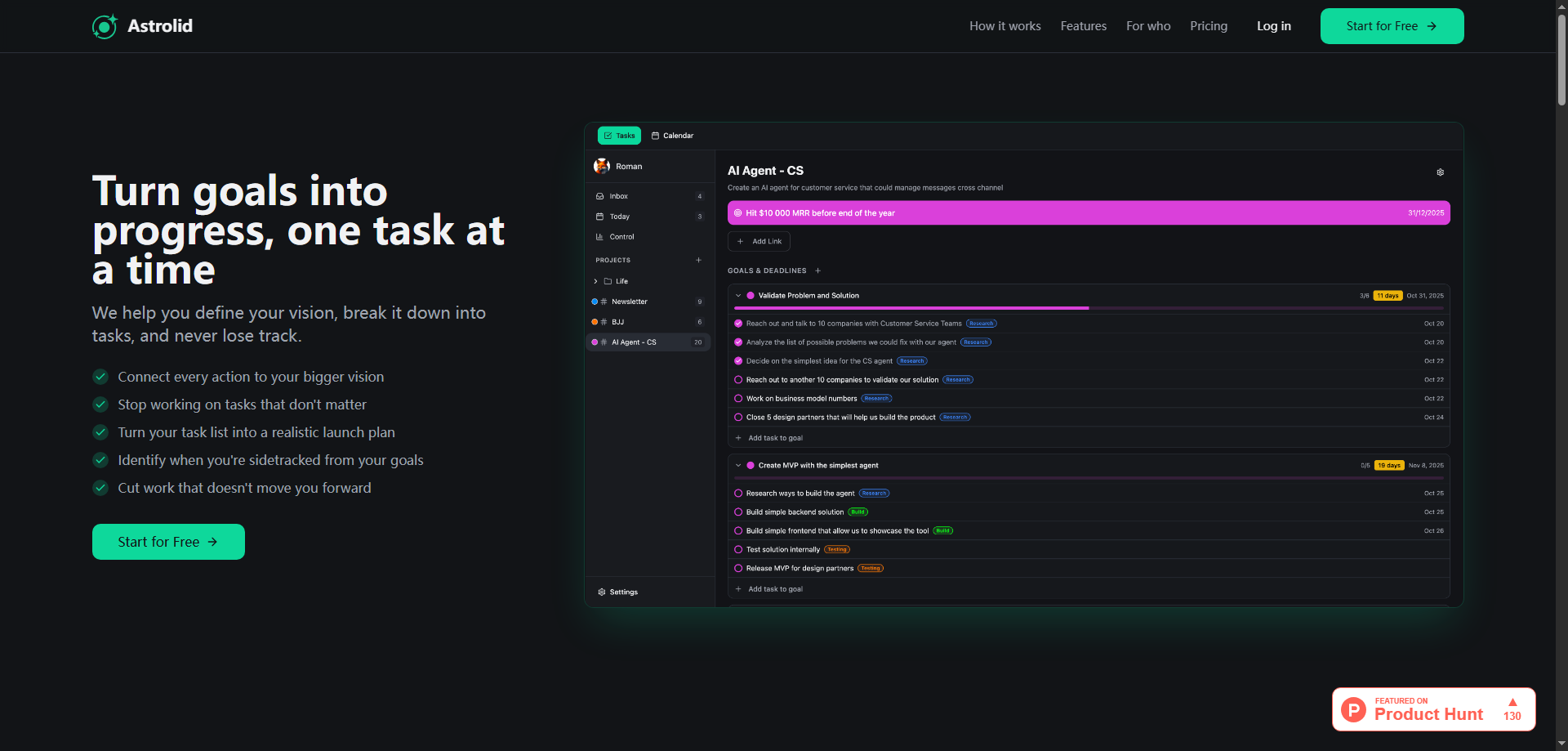1. From a Creative Perspective: Turning Work Into a Visible Journey of Progress
As a creator and founder, I’ve tried countless project management tools — and honestly, most of them feel like spreadsheets pretending to be productivity apps. But Astrolid? It’s different. It’s creative, visual, and surprisingly emotional.
Where other tools focus on checklists, Astrolid focuses on meaning. Every task you create connects directly to a larger goal — your project’s North Star. The moment you complete a task, you don’t just check it off — you see how it moves you closer to your end vision.
And that’s where the magic happens. Suddenly, progress becomes visible. Motivation feels natural. You’re no longer working through endless to-do lists — you’re building momentum.
What I love most is how Astrolid celebrates progress, not perfection. It’s not just about managing projects — it’s about feeling your growth. Each small win feels like a creative step toward something meaningful.
In a world full of sterile management software, Astrolid feels alive — a creative companion that understands how visual feedback fuels human motivation.
2. From a Disruptive Perspective: Can It Replace Existing Project Tools?
Now here’s the big question: can Astrolid really disrupt the giants like Asana, Trello, or Notion? In some ways, yes — and that’s what makes it so intriguing.
The difference is philosophical. Most tools organize your tasks; Astrolid gives your tasks purpose. It’s not about managing workload — it’s about aligning effort with intention. By showing the impact of every action on your larger goal, it bridges the gap between planning and motivation.
This isn’t just workflow automation — it’s psychological design. It taps into intrinsic motivation, turning project management into a gamified, dopamine-rich experience. When I use Astrolid, I don’t feel overwhelmed by lists — I feel driven by clarity.
Could it replace traditional tools for everyone? Not yet — big enterprises might still prefer complex integrations. But for creators, founders, and independent makers, this could absolutely become their go-to productivity partner.
Where competitors emphasize structure, Astrolid emphasizes progress energy. And that shift is quietly revolutionary.
3. From a Demand Perspective: Why Users Are Loving It (and I Totally Get Why)
Let’s be honest — the demand for project tools isn’t the issue; the frustration with them is. Most of us want to feel in control of our progress, not buried under lists and deadlines. That’s exactly why Astrolid is resonating with users right now.
With 126 upvotes and growing buzz on Product Hunt, creators, freelancers, and early-stage founders are flocking to it because it hits a nerve — it doesn’t just manage tasks, it motivates humans.
When I started using it, something clicked: I finally saw how my daily work connected to my ultimate goals. It wasn’t just “finish the feature” or “write the chapter” — it was “this step moves my dream forward.”
For creative minds and self-starters, that emotional connection changes everything. It keeps burnout away and focus sharp. That’s why users aren’t just adopting Astrolid; they’re sticking with it.
It meets a real psychological need: the need to see progress, feel purpose, and celebrate productivity without overcomplicating the process.
Astrolid isn’t just another project tool — it’s a motivational framework disguised as one.
4. One-Year Survival Forecast: ⭐️⭐️⭐️⭐️⭐️ (5 out of 5 Stars)
If I had to bet on it, I’d say Astrolid not only survives the next year — it thrives.
⭐️⭐️⭐️⭐️⭐️ (5 out of 5 Stars)
Opportunities:
- Psychological advantage: By connecting progress to motivation, Astrolid appeals to a deeper human drive than traditional tools.
- Creator-first focus: Its user base — creators, founders, and craftsmen — is expanding fast and hungry for emotionally intelligent tools.
- Visual productivity trend: As users crave less “corporate” software and more intuitive, beautiful tools, Astrolid hits the sweet spot.
- Scalability: The goal-linked model could easily expand into OKR systems, startup dashboards, or personal productivity tracking.
Risks:
- Feature parity: Competing tools like Notion or ClickUp offer wide ecosystems. Astrolid must stay focused on its emotional niche to stand out.
- Market education: Users might not immediately understand how “goal-linked tasks” differ from traditional lists — clear onboarding will be crucial.
- Team adoption: It shines for individuals and small teams, but scaling to large organizations might require deeper collaboration features.
Still, these risks are manageable. The market is shifting toward intentional productivity — tools that make people feel progress, not pressure. And Astrolid is ahead of that curve.
If it keeps refining its user experience and storytelling, I can easily see it becoming the next “cult favorite” in the creative productivity space — the app people don’t just use, but swear by.
Final Thoughts
For me, Astrolid isn’t just another project management tool — it’s a mindset shift. It transforms how I see work.
Every task feels meaningful because it’s tied to something bigger. Every bit of progress feels rewarding because it’s visible. And every day feels purposeful because I can see exactly how far I’ve come — and how close I am to what matters most.
In an age where productivity often feels like a burden, Astrolid makes it feel like an adventure again. It’s beautifully designed, psychologically smart, and refreshingly human.
If you’ve ever felt lost in your to-do lists or burned out by project chaos, give Astrolid a try. It doesn’t just organize your work — it reignites your motivation.









